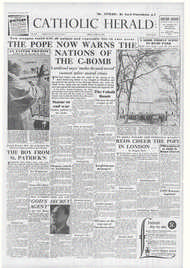Page 6, 23rd April 1954
Page 6

Report an error
Noticed an error on this page?If you've noticed an error in this article please click here to report it.
Tags
Share
Related articles
Art And Worship
Sacred Art Today
Arbitrary
Holy Office Renews Papal Directions
Where Were The Catholics?
' Stop stammering
and speak clearly'
TChurch does not oppose the modernisation of art, but it Insists that modern art be worthy of the House of God. It cannot tolerate "artistic" monstrosities inspired by a "mania for modernity" and calculated to offend the piety of the faithful.
This was the theme of an article by Cardinal Costantini, an authority on sacred art, in Fede e Arte (Faith and Art), an international magazine devoted to sacred art and published in Vatican City.
The article, which made frequent reference to the "Instruction to Ordinaries on Sacred Art" issued in 1952 by the Sacred Congregation of the Holy Office, took up the entire issue of the review.
In a foreword to his article, Cardinal Costantini declared that one of the specific purposes of the review is to oppose the penetration into churches of "the figurative blasphemy of a certain type of modern art."
Cardinal Cost antini defined "figurative blasphemy" as misshapen and deformed pictures, statues and other art objects which wrongfully claim a sacred character.
Cardinal Costantini sharply criticised "some artists who have presented the Crucified Christ in a debased, almost brutal, appearance."
He declared that many artists, as well as some priests and religious, have a craving for modernity and believe they can justify new artistic trends which others have severely criticised. He condemned the "return
to archaic primitivism and the infantilism of primitive peoples."
"The Church," he continued, "desires a worthy and decent modernity, but not a barbaric stammering in place of a human language."
Cardinal Costantini said that art which deserves to be called sacred must be constructive, liturgical. catechistic and decorative.
The article was entitled "I Have Loved, 0 Lord, The Beauty of Thy House."
blog comments powered by Disqus







